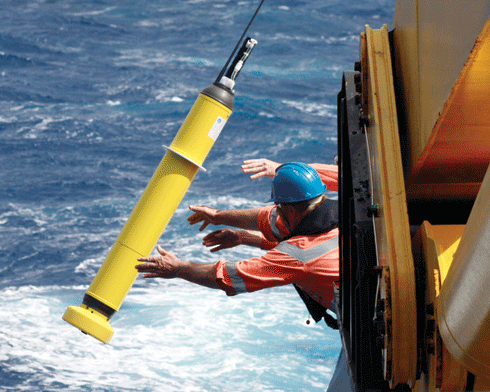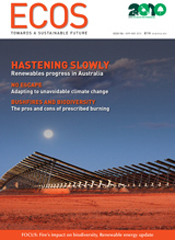
|
Published:
Winds open window onto the deep sea
Australian and US scientists have been investigating the impact of wind variability on the Southern Ocean surface layer. Their research, published recently in Nature Geoscience, helps us understand processes that have a major influence on the rate of climate change.

|
|
Deploying an Argo ocean profiler in the Southern Ocean. Credit: Alicia Navidad
|
When it began in the early part of this century, the international Argo project set a target to launch 3000 oceanographic profiling samplers into the world’s oceans. In less than a decade, about 6800 robotic profilers have been launched of which 3350 are still operating, reporting every 10 days via satellite on conditions in the upper ocean. The result is an explosion of data on the upper ocean.
The Southern Ocean has historically been poorly sampled because of adverse seasonal conditions and the small number of research platforms suitable for deployment. Thus data from the profilers has been a boon to scientists. For the first time, they can see year round how the depth of the surface layer changes (to a depth of two kilometres) with the seasons and from year-to-year.
For the last 50 years, westerly winds have been intensifying in the southern hemisphere, and have been shifting closer to the Antarctic continent.
Dr Jean-Baptiste Sallée, lead author of the study and an oceanographer with the CSIRO Wealth from Oceans Flagship, says the shift in winds is one of the strongest trends in southern hemisphere climate over the last 30 years. ‘The key question to ask is how much does the wind change affect the ocean?’, says Dr Sallée.
The latest study to take advantage of seven years of Southern Ocean Argo data has opened a window on how wind changes drive depth variations in the surface layer of sea water responsible for regulating exchanges of heat and carbon dioxide between the ocean and the atmosphere.
Dr Sallée says oceans can be schematically divided in two layers: interior and surface, the latter being a crucial pathway between the atmosphere and the deeper layers of the ocean. Changes in surface layer depth can affect air-sea exchange, and carbon and heat storage in the ocean. Surface layer depth changes also impact on biological productivity, by altering how much light and nutrients are available to support growth of plankton at the base of the food chain.
The world’s oceans absorb and sequester gases such as carbon dioxide and are therefore buffers, limiting the greenhouse effect. The Southern Ocean represents 40 per cent of the world’s total ocean carbon storage but some recent studies have suggested a possible slowdown of carbon uptake in this ocean.
‘We really need to better understand the behaviour of the surface layer in the Southern Ocean to be able to understand such phenomena and increase the accuracy of climate models,’ says Dr Sallée.
‘Models predict that increase of greenhouse gas emissions will cause strengthening of the wind in the next hundred years. But we don’t know how the wind affects the ocean.’
The researchers, including Dr Steve Rintoul from the Antarctic Climate and Ecosystems CRC and CSIRO and Professor Kevin Speer from Florida State University, have used the growing Argo data sets to show that the depth of the water mass directly beneath the surface, called the mixed layer, is more sensitive to the wind pattern known as the Southern Annular than scientists had thought. This wind pattern is the major mode of variability of the southern hemisphere atmosphere.
‘Even more surprising was the fact that the response varies a lot in different regions,’ says Dr Sallée.
When the winds strengthen and contract closer to Antarctica, the surface layer deepens in the eastern Indian and central Pacific oceans, and shallows in the western part of these basins. The reverse is seen when the winds weaken and migrate north.
The asymmetry can be explained by small deviations in the generally west-to-east winds and their effect on the heat exchange between ocean and atmosphere: when cold winds blow from the south, this causes heat loss from the ocean and deeper mixed layers.
‘These observation-based studies represent both an interesting target for future climate model improvement and a wonderful basis for biologist and biochemists to investigate impact of climate change on micro-organisms,’ says Dr Sallée.



